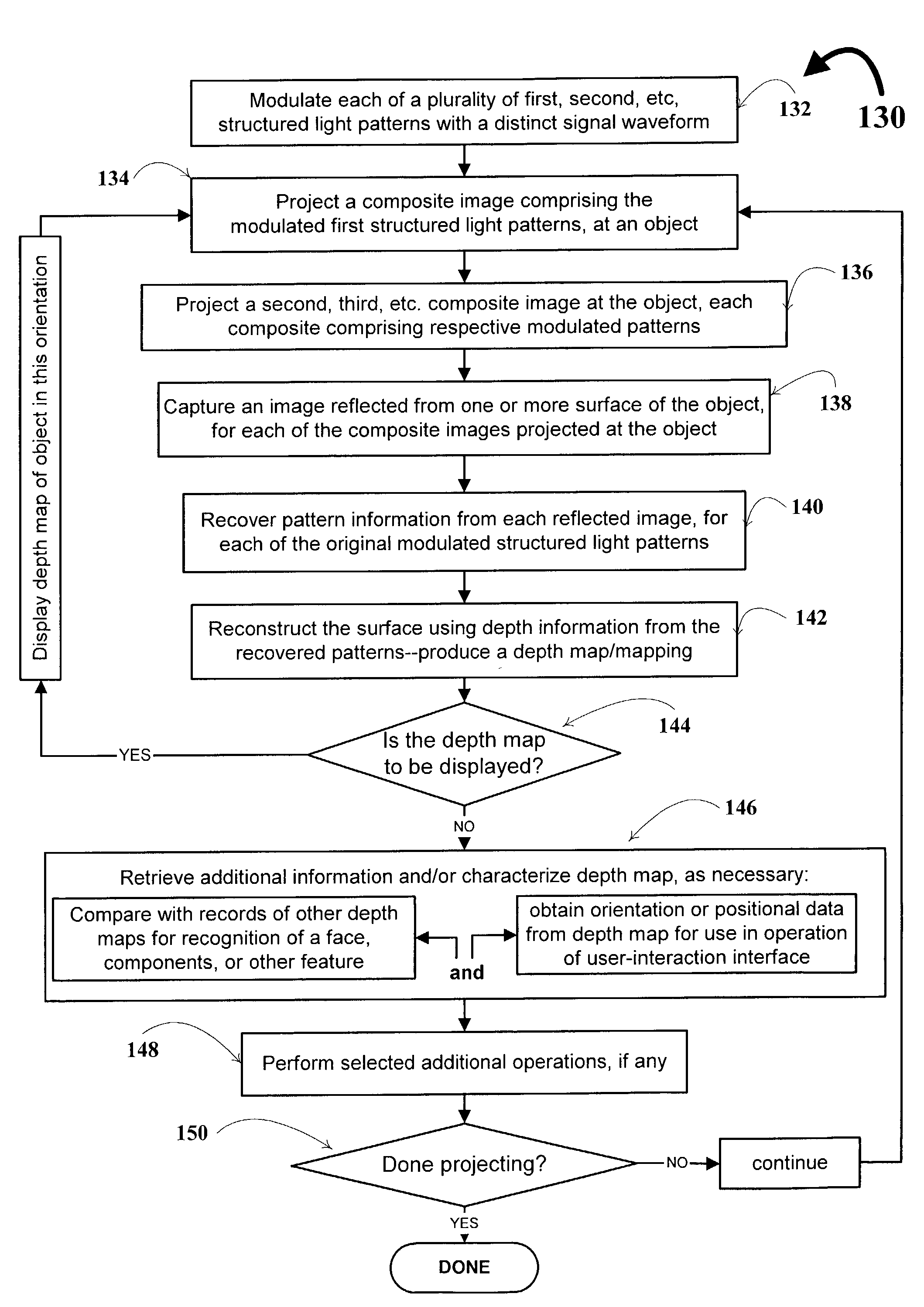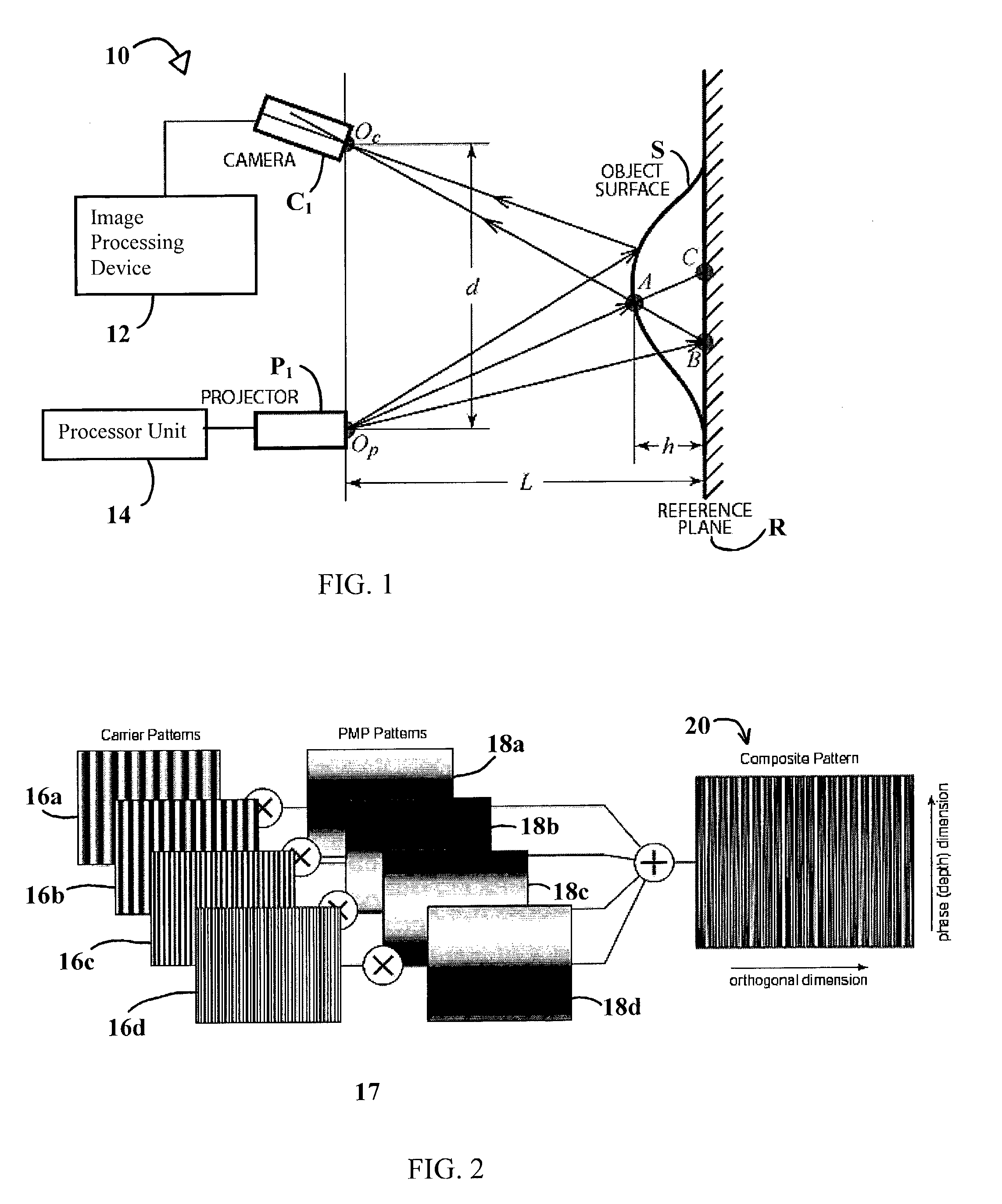System and technique for retrieving depth information about a surface by projecting a composite image of modulated light patterns
a composite image and surface technology, applied in the field of structured light systems, can solve the problems of cumbersome process, cumbersome process, and known structured light illumination techniques used for automated inspection and measuring surface topologies, and achieve the effect of more detailed and/or larger depth mappings
- Summary
- Abstract
- Description
- Claims
- Application Information
AI Technical Summary
Benefits of technology
Problems solved by technology
Method used
Image
Examples
example 1a
Derivation & Analysis Discussion-Composite Patterning Employing PMP
[0049]The PMP range finding method has several advantages, it is a pixel-wise calculation, resistant to ambient light, resistant to reflection variation and it can have as few as three frames for whole-field depth reconstruction. Sinusoid patterns are projected and shifted by a factor of 2;T / N for N times as
Inp(xp,yp)=Ap+Bp cos(2πfφyp−2πn / N) Eqn. (1)
where Ap and Bp are the projection constants and (xp, yp) is the projector coordinates. The yp dimension is in the direction of the depth distortion and is called the phase dimension. On the other hand, xp dimension is perpendicular to the phase dimension, so it has been coined herein, the orthogonal dimension. Thus, frequency f100 of the sinusoid wave is in the phase direction / dimension. The subscript n represents the phase shift index and n=1, 2, . . . , N. where N is the total number of phase shifts.
[0050]The reflected intensity images from the object surface after su...
example 1b
Addendum Summary to Discussion and Analysis Employing PMP
[0066]As mentioned, one core feature of the technique of the invention is the projection of a composite 20, FIG. 2 of modulated patterns. Assuming scale and offset of the composite function has a transmittance between 0 and 1, the composite image may be represented by the following expression:
[0067]Scp(x,y)=∑n=1Nfn(x)φn(y)Expression[I]
The structured light pattern set is represented with a 1-D function fn(x) where x is along the phase dimension. The modulating function is φn(y) where y is along the orthogonal dimension. The index is n=1, 2, . . . N. Drawing from communications concepts to use AM frequency division multiplexing, encode the N patterns. Let
φn(y)=A(1+cos(2πfy,ny)) Expression [II]
where A is a scaling constant and fy,n is the orthogonal frequency.
[0068]The well known multi-pattern PMP technique employed here to provide the structured light patterns for use in the composite pattern, uses phase shifted sinusoids...
example 1c
Summary of Application of Techniques Discussed in Examples 1A-1B
[0084]Referencing the various FIGs throughout this EXAMPLE 1C, the following is provided merely for purposes of further understanding the novel features of the invention. A Texas Instruments (TI) Digital Light Processor (DLP) projector, P1, was used with an 800×600 micro-mechanical mirror array. The framegrabber 12, a DT3120, grabs the image from the CCD monochrome camera with spatial resolution of 640×480 with 8 bits intensity resolution. To simplify decoding, the frequency across the phase direction A, is selected to be unit, or 1, frequency: No unwrapping algorithm need be implemented. In this experiment, number of patterns, N=4; carrier frequencies of the projector fnp were 50, 85, 120 and 155 cycles per field of view for an orthogonal field of view width of 800 pixels. The corresponding received carrier frequencies were 33, 56, 79, and 103 cycles per field of view with a field of view of 640 pixels. The lowest modu...
PUM
 Login to View More
Login to View More Abstract
Description
Claims
Application Information
 Login to View More
Login to View More - R&D
- Intellectual Property
- Life Sciences
- Materials
- Tech Scout
- Unparalleled Data Quality
- Higher Quality Content
- 60% Fewer Hallucinations
Browse by: Latest US Patents, China's latest patents, Technical Efficacy Thesaurus, Application Domain, Technology Topic, Popular Technical Reports.
© 2025 PatSnap. All rights reserved.Legal|Privacy policy|Modern Slavery Act Transparency Statement|Sitemap|About US| Contact US: help@patsnap.com



